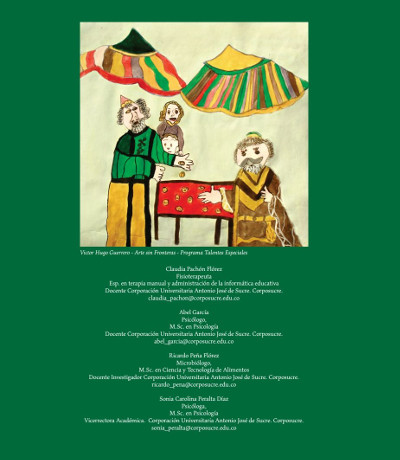Programa de rehabilitación integral en pacientes con dolor crónico de espalda: un estudio de caso
Contenido principal del artículo
Autores
Claudia Pachón Flórezclaudia_pachon@corposucre.edu.co
Abel García
abel_garcia@corposucre.edu.co
Ricardo Peña Flórez
ricardo_pena@corposucre.edu.co
Sonia Carolina Peralta Díaz
sonia_peralta@corposucre.edu.co
Resumen
La utilización de estrategias combinadas para el manejo de pacientes con dolor crónico, ha demostrado eficacia en su recuperación. Este trabajo tiene como objetivo mostrar la aplicación de abordajes psicológicos y fisioterapéuticos en la rehabilitación de un paciente masculino de 62 años con dolor crónico de espalda. Las estrategias fisioterapéuticas aplicadas se basaron en la aplicación de técnicas Tens, Ultrasonido, ejercicios de balonterapia, ejercicios isométricos e isotónicos, medios físicos, técnica de Mckenzy y ejercicios de cadenas cinética, las cuales se suministraron con una duración de 1 hora por cada sesión diaria, durante un periodo de 15 días y el efecto del tratamiento aplicado se evaluó mediante la valoración de problemas osteomusculares (OM). El tratamiento psicológico de acompañamiento se basó en un entrenamiento cognitivo conductual (ECC) suministrado con una periodicidad semanal; el nivel de mejora de vida del paciente fue medido con la escala de ansiedad Hamilton, y el cuestionario de estrategias de afrontamiento (CIQ) y Euro-gol. Las valoraciones fisioterapéuticas se aplicaron antes, durante y después del tratamiento, mientras que las valoraciones psicológicas se aplicaron antes y después, y demostraron una rehabilitación integral eficiente; disminuyendo el dolor crónico de espalda, aumentando la movilidad y mejorando la calidad de vida al disminuir los índices de dolor a la palpación y al movimiento, medida en escala numérica de Borg. Igualmente se observó disminución en el índice de discapacidad lumbar de Oswestry, disminución en los niveles de ansiedad y recuperación total del paciente lo que demuestra que la rehabilitación integral del paciente fue eficaz.
Palabras clave:
Detalles del artículo
Licencia
Aquellos autores/as que tengan publicaciones con esta revista, aceptan los términos siguientes:
- Los autores/as conservarán sus derechos de autor y garantizarán a la revista el derecho de primera publicación de su obra, el cuál estará simultáneamente sujeto a la Licencia de reconocimiento de Creative Commons que permite a terceros compartir la obra siempre que se indique su autor y su primera publicación esta revista.
- Los autores/as podrán adoptar otros acuerdos de licencia no exclusiva de distribución de la versión de la obra publicada (p. ej.: depositarla en un archivo telemático institucional o publicarla en un volumen monográfico) siempre que se indique la publicación inicial en esta revista.
- Se permite y recomienda a los autores/as difundir su obra a través de Internet (p. ej.: en archivos telemáticos institucionales o en su página web) antes y durante el proceso de envío, lo cual puede producir intercambios interesantes y aumentar las citas de la obra publicada. (Véase El efecto del acceso abierto).
Los autores que publican en la revista se acogen al código de licencia de Creative Commons Atribución 4.0 Internacional (CC BY 4.0)




Referencias
Baker, R., Thomas, S., Thomas, P.W., Gower, P., Santonastaso, M., & Whittlesea, A. (2010). The emotional processing scale: scale refinement and abridgement (EPS-25). Journal of Psychosomatic Research, 68(1), 83-88.
Baker, R., Thomas, S., Thomas, P.W., & Owens, M. (2007). Development of an emotional processing scale. Journal of Psychosomatic Research,62(2), 167-178.
Brox, J., Storheim, K., Holm, I., Friis, A., & Reikerås, O. (2005). Disability,pain, psychological factors and physical performance in healthy controls, patients with sub-acute and chronic low back pain: a case-control study. Journal of Rehabilitation Medicine, 37(2), 95–99.
Burns, J.W., Bruehl, S., & Quartana, P.J. (2006). Anger management style and hostility among patients with chronic pain: effects on symptom-specific physiological reactivity during anger- and sadness-recall interviews. Journal of Psychosomatic Research, 68(5), 786–793.
Burns, J.W., Quartana, P.J., & Bruehl, S. (2011). Suppression of anger and subsequent pain behaviours among chronic low back pain patients: moderating effects of anger regulation style. Annals of Behavioral Medicine, 42(1), 42-54.
Carson, J.W., Keefe, F.J., Lowry, K.P., Porter, L.S., Goli, V., & Fras, A.M. (2007). Conflict about expressing emotions and chronic low back pain: associations with pain and anger. Journal of Pain, 8(5), 405–411.
Chatters, L.M. (2000). Religion and health: public health research and practice. Annual Review of Public Health, 21, 335-367. doi: 10.1146/annurev.publhealth.21.1.335
Cherkin, D.C., Deyo, R.A., Street, J.H., Hunt, M., Barlow, W. (1996). Pitfalls of patient education. Limited success of a programfor back pain in primary care. Spine, 21(3), 345-355.
Craig, K.D. (1994). Emotional aspects of pain. En R. Melzack & P. Wall (Eds.), Textbook of Pain (pp. 261-274). London: Churchill Livingstone.
Dersh, J., Gatchel, R.J., & Polatin, P. (2001). Chronic spinal disorders and psychopathology: research findings and theoretical considerations. The Spine Journal, 1(2), 88-94.
Descarreaux, M., Jean-Sebastien, B., Drolet, M., Papadimitriou, S., & Teasdale, N. (2004). Efficacy of preventative spinal manipulation for chronic low-back pain and related disabilities: a preliminary study. Journal of Manipulative and Physiological Therapeutics, 27(8), 509-514.
Diers, M., Koeppe, C., Diesch, E., Stolle, A.M., Holzl, R., Schiltenwolf, M., Ackern, K., & Flor, H. (2007). Central processing of acute musclepain in chronic low back pain patients: an EEG mapping study. Journal of Clinical Neurophysiology, 24(1), 76-83.
Esteves, J.E., Wheatley, L., Mayall, C. & Abbey, H. (2013). Emotional processing and its relationship to chronic low back pain: Results from a case-control study. Manual Therapy, 18(6), 541-546.
Gatchel, R.J. (1996). Psychological disorders and chronic pain: Cause-andeffect relationships. R.J. Gatchel, & D.C. Turk, (Eds), Psychological approaches to pain management: A practitioners handbook (pp. 33-52). New York: Guilford Publications.
Giesecke, T., Gracely, R.H., Clauw, D.J., Nachemson, A., Duck, M.H., Sabatowski, R., Gerbershagen, H.J., Williams, D.A., & Petzke, F. (2006).
Central pain processing in chronic low back pain. Evidence for reduced pain inhibition. Schmerz, 20(5), 411-414.
Goldin, P.R., McRae, K., Ramel, W., & Gross, J.J. (2008). The neural bases of emotion regulation: reappraisal and suppression of negative emotion. Biological Psychiatry, 63(6), 577-586.
Grachev, I.D., Fredrickson, B.E., & Apkarian, A.V. (2000). Abnormal brain chemistry in chronic back pain: an in vivo proton magnetic reso- nance spectroscopy study. Pain, 89(1), 7-18.
Guehring, T., Omlor, G.W., Lorenz, H., Engelleiter, K., Richter, W., Cars-tens, C., & Kroeber, M. (2006). Disc distraction shows evidence of regenerative potential in degenerated intervertebral discs as evaluated by protein expression, magnetic resonance imaging, and messenger ribonucleic acid expression analysis. Spine, 31(15), 1658-1665.
Hartvigsen, J., Christensen, K., & Frederiksen, H. (2003). Back pain remains a common symptom in old age A population-based study of 4486 Danish twins aged 70–102. European Spine Journal, 12(5), 528–534.
Henschke, N., Ostelo, R.W., Van Tulder, M.W., Vlaeyen, J.W., Morley, S., Assendelft, W.J., & Main, C.J. (2010). Behavioural treatment for chronic low-back pain. Cochrane Database of Systematic Reviews, 7(CD002014). doi: 10.1002/14651858.CD002014.pub3.
Heymans, M.W., Van Tulder, M.W., Esmail, R., Bombardier, C., & Koes, B.W. (2005). Back schools for non-specific low back pain: a systematic review within the framework of the Cochrane Collaboration back review group. Spine, 30(19), 2153-2163.
Hides, J.A., Jull, G.A., Richardson, C.A. (2001). Long-term effects of specific stabilizing exercises for first-episode low back pain (see com- ment). Spine, 26(11), E243-E248.
Hoffman, B.M., Papas, R.K., Chatkoff, D.K., & Kerns, R.D. (2007). Meta-analysis of psychological interventions for chronic low back pain. Health Psychology, 26(1), 1–9.
Hofmann, S.G., Asnaani, A., Vonk, I.J., Sawyer, A.T., & Angela Fang, M.A. (2012). The Efficacy of Cognitive Behavioral Therapy: A Review of Meta-analyses. Cognition Therapy and Research, 36(5), 427–440.
Jones, T.R., & Rao, R. (2008). Pathophysiology of Axial Low Back Pain. Seminars in Spine Surgery, 20(2), 78-86.
Kabat-Zinn, J. (1990). Full catastrophe living: using the wisdom of your body and mind to face stress, pain and illness. New York: Delacorte.
Katon, W.J. (1996). The impact of major depression on chronic medical illness. Gen Hosp Psychiatry, 18(4), 215-219.
Kovacs F. (2002). Manejo clínico de la lumbalgia inespecífica. Semergen, 28(1), 1-3.
Levin, J. (2009). How faith heals: a theoretical model. Explore, 5(2), 77-96.
Liddle, S.D., Gracey, J.H., & Baxter, G.D. (2007). Advice for the management of low back pain: a systematic review of randomised controlled trials. Manual Therapy, 12(4), 310-327.
Lindgren, L., Rundgren, S., Winsö, O., Lehtipalo, S., Wiklund, U., Karlsson, M., Stenlund, H., Jacobsson, C., & Brulin, C. (2010). Physiological responses to touch massage in healthy volunteers. Autonomic Neuroscience, 158(1-2), 105-110.
Lindgren, L., Westling, G., Brulin, C., Lehtipalo, S., Andersson, M., & Nyberg, L. (2012). Pleasant human touch is represented in pregenual anterior cingulate cortex. Neurolmage, 59(4), 3427-3432.
Manchikanti, L., Pampati, V., Beyer C., Damron, K., & Barnhill, R.C. (2002). Evaluation of psychological status in chronic low back pain: comparison with general population. Pain Physician, 5(2), 149–155.
Merskey, H., & Bogduk, N. (1994). Classification of chronic pain: Description of chronic pain syndromes and definition of pain terms. Seattle WA: IASP Press.
Miller, L.R., & Cano, A. (2009). Comorbid chronic pain and depression: who is at risk? Journal of Pain, 10(6), 619–627.
Mimura, M., Panjabi, M.M., Oxland, T.R., Crisco, J.J., Yamamoto, I., & Vasavada, A. (1994). Disc degeneration affects the multidirectional flexibility of the lumbar spine. Spine, 19(12), 1371-1380.
Ole Kudsk, J., Claus Vinther, N., Kristian, & S.P. (2009). Low back pain may be caused by disturbed pain regulation: a cross-sectional study in low back pain patients using tender point examination. European Journal of Pain, 14(5), 514-522.
Orozco-Torres, M.L. (2005). Dolor crónico como problema de salud y su evaluación. Revista anestesia en México, 17(1), 4-11.
Pincus, T., Burton, A.K., Vogel, S., & Field, A.P. (2002). A systematic review of psychological factors as predictors of chronicity/disability in prospective cohorts of low back pain. Spine, 27(5), E109–E120.
Roberts, J.A., & Wolfe, T.M. (2012). Chiropractic management of a veteran with lower back pain associated with diffuse idiopathic skeletal hypertrophy and degenerative disk disease. Journal of Chiropractic Medicine, 11(4), 293–299. doi: 10.1016/j.jcm.2012.10.007
Rudy, T.E., Weiner, D.K., Lieber, S.J., Slaboda, J., & Boston, J.R. (2007). The impact of chronic low back pain on older adults: A comparative
study of patients and controls. Pain, 131(3), 293–301.
Safran, J., & Segal, Z. (1990). Interpersonal process in cognitive therapy. New York: Basic Books.
Schmidt-Wilcke, T., Leinisch, E., Gänssbauer, S., Draganski, B., Bogdahn, U., Altmeppen, J., May, A. (2006). Affective components and intensity of pain correlate with structural differences in gray matter in chronic back pain patients. Pain, 125(1-2), 89-97.
Segal, Z.V., Williams, J.MG., Teasdale, J.D. (2002). Mindfulness-based cognitive therapy for depression: a new approach to preventing relapse. New York: Guilford Press.
Séguin, C.A., Pilliar, R.M., Roughley, P.J., Kandel, R.A. (2005). Tumor necrosis factor-alpha modulates matrix production and catabolism in nucleus pulposus tissue. Spine, 30(17), 1940-1948.
Shapiro, S.L., Carlson, L.E., Astin, J.A., & Freedman, B. (2006). Mechanisms of mindfulness. Journal of Clinical Psychology, 62(3), 373–386.
Smeets, R., Vlaeyen, J., Hidding, A., Kester, A., Van der Heijden, G.J., & Knottnerus, J.A. (2008). Chronic low back pain: Physical training, graded acti- vity with problem solving training, or both? The one-year post-treatment results of a randomized controlled trial. Pain, 134(3), 263–276.
Smeets, R.J., Wade, D., Hidding, A., Van Leeuwen, P.J., Vlaeyen, J.W., & Knottnerus, J.A. (2006). The association of physical deconditioning and chronic low back pain: a hypothesis-oriented systematic review. Disability and Rehabilitation, 28(11), 673–693.
Svensson, L., Narlid, I., & Oldberg, A. (2000). Fibromodulin and lumican bind to the same region on collagen type I fibrils. FEBS Letters, 470(2), 178-182.
Tanaka, N., An, H.S., Lim, T.H., Fujiwara, A., Jeon, C.H., & Haughton, V.M. (2001). The relationship between disc degeneration and flexibility of the lumbar spine. The Spine Journal, 1(1), 47-56.
Thomas, E., Peat, G., Harris, L., Wilkie, R., & Croft, P.R. (2004). The prevalence of pain and pain interference in a general population of older adults: cross-sectional findings from the North Staffordshire Osteoarthritis Project (NorStOP). Pain, 110(1-2), 361–368.
Thomas, E., Silman, A.J., Papageorgiou, A.C., Macfarlane, G.J., Croft, P.R.(1998). Association between measures of spinal mobility and low back pain. An analysis of new attenders in primary care. Spine, 23(3), 343-347.
Tracey, I., & Bushnell, M.C. (2009). How neuroimaging studies have challenged us to rethink: is chronic pain a disease? The Journal of Pain, 10 (11), 1113-1120.
Turk, D.C. (2005). The potential of treatment matching for subgroups of patients with chronic pain: lumping versus splitting. Clinical Journal of Pain, 21(1), 44–55.
Veehof, M.M., Oskam, M.J., Schreurs, K.M., & Bohlmeijer, E.T. (2011).Acceptance-based interventions for the treatment of chronic pain: A systematic review and meta-analysis. Pain, 152(3), 533–542. doi:10.1016/j.pain.2010.11.002.
Verbunt, J.A., Seelen, H.A., Vlaeyen, J.W., Van de Heijden, G.J., Heuts, P.H., Pons, K., & Knottnerus, J.A. (2003). Disuse and deconditioning in chronic low back pain: concepts and hypothesis on contributing mechanisms. European Journal Pain, 7(1), 9–21.
Verbunt, J.A., Seelen, H.A., Vlaeyen, J.W., Van de Heijden, G.J., Heuts, P.H., Pons, K., & Knottnerus, J.A. (2003). Disuse and deconditioning in chronic low back pain: concepts and hypothesis on contributing mechanisms. European Journal Pain, 7(1), 9–21.
Vlaeyen, J.W., & Crombez, G. (1999). Fear of movement/(re)injury, avoidance and pain disability in chronic low back pain patients. Manual Therapy, 4(4), 187-195.
Yang, K.H., King, A.I. (1984). Mechanism of facet load transmission as a hypothesis for low-back pain. Spine, 9(6), 557-565.
Wand, B.M., Parkitny, L., O’Connell, N.E., Luomajoki, H., McAuley, J.H., Thacker, M., & Moseley, G.L. (2011). Cortical changes in chronic low back pain: current state of the art and implications for clinical practice. Manual Therapy, 16 (1), 15-20.
Watanabe, H., Yamada, Y., & Kimata, K. (1998). Roles of aggrecan, a large chondroitin sulfate proteoglycan, in cartilage structure and function. Journal Biochemical, 124 (4), 687-693.
Whelton, W.J. (2004). Emotional processes in psychotherapy: evidence across therapeutic modalities. Clinical Psychology and Psychotherapy, 11(1), 58-71.


 PDF
PDF
 XML
XML










